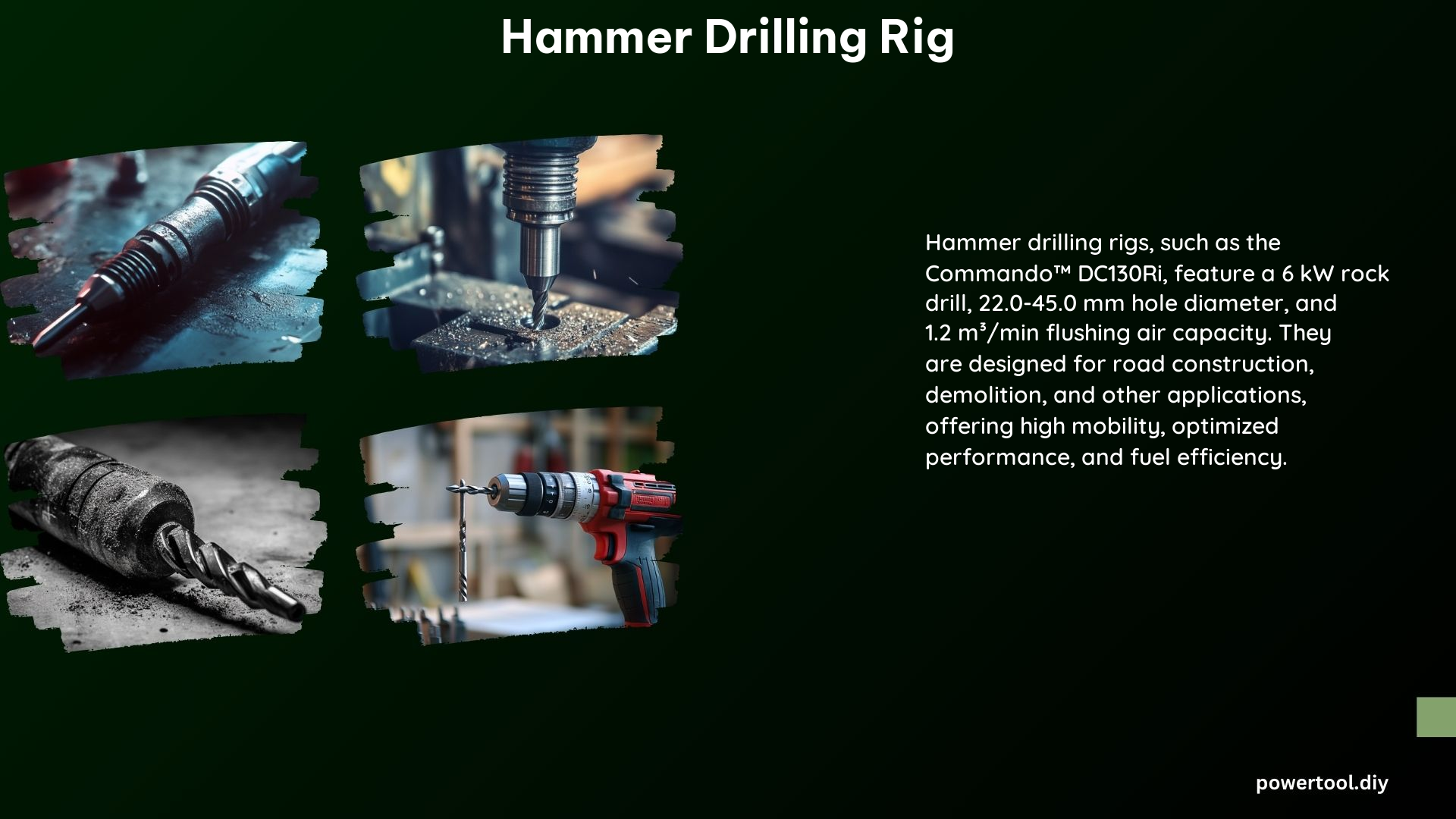Hammer drilling rigs are specialized pieces of equipment used for a wide range of applications, including pre-drilling hard rock, micro piling, geothermal, solar, foundation, dewatering, water well drilling, and geotechnical projects. These rigs are designed to handle the demands of drilling through tough, abrasive rock formations, offering high-performance and efficient drilling capabilities.
Types of Hammer Drilling Rigs
Top Hammer Drill Rigs
Top hammer drill rigs are engineered for drilling smaller holes, typically up to 254 mm (10 inches) in diameter. They are commonly used for pre-drilling foundation piles, micro piling, and geotechnical applications. These rigs feature a top-mounted rock drill that delivers powerful percussive blows to the drill bit, allowing for efficient penetration of hard rock formations.
Down-the-Hole (DTH) Drill Rigs
Down-the-Hole (DTH) drill rigs are designed for drilling larger holes and are well-suited for applications such as quarry drilling, shallow water well drilling, and underground blasthole drilling. DTH hammers are specifically engineered for high-performance drilling in a variety of rock formations, offering superior penetration rates and productivity.
Key Features and Specifications

Drilling Depth
The maximum drilling depth of a top hammer drill rig can vary significantly depending on the specific model and application. For instance, the Commando DC130Ri surface top hammer drill rig from Sandvik can drill holes up to 45 mm (1.8 inches) in diameter to a maximum depth of 30 meters (98 feet).
Drilling Speed
Top hammer drill rigs are renowned for their high drilling speeds, which can greatly reduce production time. The K1 Drill Mast from Hammer & Steel, for example, utilizes high-power DTH hammers to increase production speeds for pre-drilling hard rock formations, achieving drilling rates of up to 30 meters (98 feet) per hour.
Rock Drill Power
The power of the rock drill is a critical factor in the performance of hammer drilling rigs. The Commando DC130Ri from Sandvik features a powerful 6 kW rock drill, providing the necessary force to efficiently penetrate tough rock formations.
Flushing Air Capacity
The flushing air capacity is essential for the efficient removal of cuttings and debris during the drilling process. The Commando DC130Ri, for instance, has a flushing air capacity of 1.2 m³/min (42.4 ft³/min) up to 8 bar (116 psi), ensuring optimal hole cleaning and productivity.
Technical Specifications
Hole Diameter
Top hammer drill rigs are typically capable of drilling holes ranging from 22 mm (0.9 inches) to 254 mm (10 inches) in diameter, depending on the specific model and application requirements.
Rock Drill Power
The rock drill power in hammer drilling rigs can vary significantly, ranging from 6 kW up to higher power outputs, depending on the rig’s design and intended use. For example, the Commando DC130Ri features a 6 kW rock drill, while larger DTH drill rigs may utilize rock drills with power outputs exceeding 30 kW.
Flushing Air Capacity
The flushing air capacity in hammer drilling rigs can range from 1.2 m³/min (42.4 ft³/min) up to 8 bar (116 psi) or higher, depending on the rig’s design and the specific drilling application. This high-volume air capacity is crucial for efficiently removing cuttings and debris from the borehole, ensuring optimal drilling performance.
DIY Considerations
When working with hammer drilling rigs, it is essential to follow proper safety protocols and maintenance procedures to ensure optimal performance and extend the life of the equipment. This includes:
- Regular inspections of the rig’s components, such as the rock drill, air compressor, and hydraulic systems, to identify any wear or damage.
- Proper storage and handling of the rig, including protecting it from the elements and ensuring it is securely transported.
- Adherence to the manufacturer’s guidelines for operation, maintenance, and troubleshooting, as each rig may have specific requirements.
- Proper training and certification for operators to ensure safe and efficient use of the equipment.
- Maintaining a comprehensive maintenance log to track service intervals, repairs, and any issues that arise.
By following these DIY considerations, you can ensure the longevity and reliable performance of your hammer drilling rig, maximizing its productivity and cost-effectiveness for your drilling projects.
References
- Mincon. (n.d.). Rock Drills – Mincon – The Driller’s Choice. Retrieved from https://mincon.com/rock-drill/
- The Driller. (2020, June 22). Hammer Drilling Rigs K1 Drill Mast. Retrieved from https://www.thedriller.com/articles/91886-hammer-drilling-rigs-k1-drill-mast
- Epiroc US. (n.d.). Down the Hole Hammers (DTH) | Complete Solution. Retrieved from https://www.epiroc.com/en-us/products/rock-drilling-tools/down-the-hole-drilling-tools/hammers
- Sandvik. (n.d.). Commando™ DC130Ri Surface top hammer drill rig. Retrieved from https://www.rocktechnology.sandvik/en/products/equipment/surface-drill-rigs/commando-dc130ri-surface-top-hammer-drill-rig/
- Hammer & Steel. (n.d.). Drill Rigs/Drilling Rig Equipment – Hammer & Steel. Retrieved from https://www.hammersteel.com/drill-rigs.html
